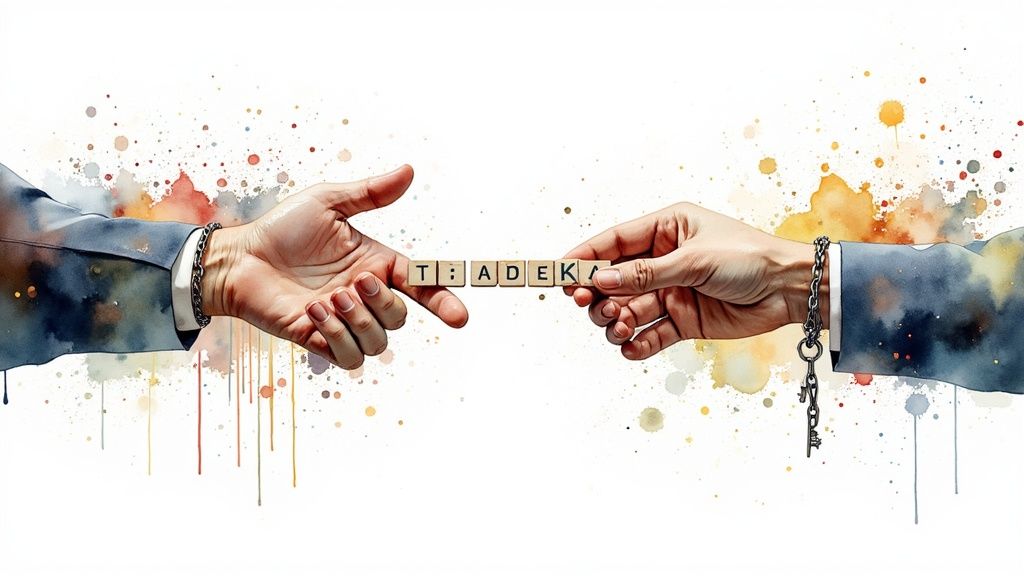



The blockchain technology market is set to reach $1.4 trillion by 2030, with an 85.9% compound annual growth rate. These numbers reflect blockchain's concrete business value across industries, well beyond its cryptocurrency origins. Let's examine how this technology tackles key business challenges and opens new possibilities.
Several fundamental capabilities are accelerating blockchain adoption:
Enhanced Security: The decentralized architecture and encryption inherent to blockchain provide robust protection against data breaches. For healthcare providers, this means patient records can be stored securely and accessed only by authorized personnel, maintaining both privacy and data integrity.
Improved Transparency and Traceability: Blockchain's permanent ledger enables end-to-end visibility of transactions and asset movements. Supply chain managers can track products from manufacture through delivery, verifying authenticity and ethical sourcing at each step. For instance, retailers can trace food products back to their source to ensure safety and quality.
Increased Efficiency and Automation: Smart contracts eliminate intermediaries and reduce manual processing, leading to faster transactions and lower costs. Financial institutions are already using blockchain to speed up cross-border payments and simplify trade finance, generating significant cost savings.
Empowering Decentralized Systems: Through decentralized applications (dApps) and organizations (DAOs), blockchain enables direct peer-to-peer interactions and community governance. This creates opportunities for new business models - like marketplaces where artists can sell directly to buyers without platform fees.
While blockchain has broad applications, certain industries are seeing rapid adoption and concrete benefits:
| Sector | Impact |
|---|---|
| Healthcare | Secure patient data management, supply chain tracking, clinical trial transparency |
| Finance | Faster cross-border transactions, automated trade processing, decentralized finance services |
| Supply Chain Management | Complete product traceability, efficient logistics, anti-counterfeiting measures |
| Government | Transparent public services, secure voting systems, digital identity solutions |
The excitement around blockchain is warranted, but success requires careful evaluation. Organizations need to thoroughly assess the technology's capabilities, limitations and fit with their specific needs. The key is not just digitizing existing processes, but fundamentally rethinking them to maximize blockchain's security, efficiency and transparency benefits. With proper planning and implementation, blockchain can deliver meaningful business value today while enabling new operational models for the future.

The integration of blockchain technology in healthcare is creating significant opportunities for improvement across the industry. Research indicates that by 2025, 55% of healthcare applications will incorporate blockchain for commercial use, signaling a major shift in how medical services operate. This adoption is set to affect multiple aspects of healthcare delivery, from medical record management to supply chain logistics.
Patient data management represents one of blockchain's most valuable applications in healthcare. The current fragmented nature of medical records creates challenges for healthcare providers trying to access complete patient histories. This fragmentation not only affects treatment quality but also raises data privacy issues. Blockchain addresses these problems by establishing a secure, unified record of patient information. For instance, medical histories, allergy information, medication lists, and test results can be stored on a blockchain, with access limited to authorized personnel who have patient consent. This approach both protects sensitive data and gives patients more control over their medical information.
The pharmaceutical sector faces significant challenges that blockchain technology can help address. Drug counterfeiting poses a major global threat to patient safety and costs billions in industry losses annually. Blockchain's ability to monitor products throughout the supply chain offers an effective solution to combat counterfeit medications. Each step from production to delivery is permanently recorded, creating a verifiable trail that confirms medication authenticity. The technology also improves logistics efficiency, reduces shipping delays, and cuts waste, resulting in better medication access for patients while maintaining rigorous safety standards.
Clinical trials stand to benefit significantly from blockchain integration. Current trial processes often face issues with speed, complexity, and cost. Blockchain improves these aspects by optimizing data collection methods, ensuring data accuracy, and promoting transparency. As an example, clinical trial data can be securely stored and distributed via blockchain, enabling researchers to analyze results more effectively and speed up treatment development. This technology also reduces fraud risk and data manipulation, leading to more reliable trial outcomes.
While blockchain shows great promise in healthcare, several obstacles need attention during implementation. Key challenges include system compatibility, regulatory requirements, and data privacy protection. Success requires careful strategic planning, stakeholder cooperation, and focus on creating simple, practical solutions for both patients and healthcare professionals. As blockchain technology evolves and implementation standards emerge, these barriers are expected to decrease. The gradual adoption of blockchain in healthcare aims to enhance patient care quality while making the entire system more secure and efficient.
Blockchain technology is fundamentally changing how financial services operate. The shift brings major improvements in efficiency, security and transparency across the industry. Early estimates suggest blockchain could reduce infrastructure costs by 30%, potentially saving financial institutions over $10 billion annually.
The current system for international payments is slow and complex, requiring multiple banks and intermediaries to process transactions. Blockchain offers a better way forward. By enabling direct peer-to-peer transfers, blockchain can complete cross-border payments in minutes rather than days. This means businesses and individuals can move money internationally without delays or excessive fees. For instance, a company paying overseas suppliers can settle transactions almost instantly, improving cash flow and reducing costs. The removal of intermediary banks also increases visibility into payment status and routing.
Trade finance is another area seeing major benefits from blockchain adoption. The traditional process involves extensive paperwork, manual checks and long approval chains that slow down international trade. Smart contracts on the blockchain can automate many of these steps. For example, when goods arrive at their destination, a smart contract can automatically trigger payment to the supplier after verifying delivery. This not only speeds up transactions but also reduces errors and fraud risk since all parties work from the same verified information.
As blockchain reshapes finance, banks are actively adapting their business models. While blockchain won't eliminate traditional banking, it is pushing institutions to modernize their services. Many banks are building blockchain platforms or partnering with fintech companies to enhance their offerings. This extends to areas like customer verification and compliance monitoring, where blockchain can make identity checks and transaction tracking more efficient. The technology allows banks to maintain regulatory standards while reducing administrative overhead.
Financial institutions face several challenges in adopting blockchain technology. Integrating new systems with existing infrastructure requires significant technical work and investment. Questions around regulations and industry standards also need resolution. However, the clear benefits of improved efficiency and reduced costs continue driving progress. Close collaboration between banks, technology providers and regulators helps establish practical frameworks for implementing blockchain solutions. These efforts are steadily building a more efficient and transparent financial system that better serves customers while maintaining security and compliance.

As AI and blockchain technologies mature, their combination creates powerful new possibilities across industries. By working together, these technologies enhance system intelligence, security, and automation capabilities. Let's explore how AI and blockchain complement each other and shape future applications.
The integration of AI with blockchain strengthens data protection in meaningful ways. While blockchain provides unchangeable transaction records, AI systems analyze patterns to detect and prevent fraud attempts. For example, AI monitors can scan blockchain activity in real-time to identify suspicious behavior before breaches occur. This dual approach to security becomes increasingly vital as data volumes grow and threats become more complex.
AI's analytical capabilities pair naturally with blockchain's transaction processing to streamline operations. Smart contracts can now incorporate AI for automated execution and decision-making based on complex data analysis. In supply chains, AI forecasts demand and manages inventory while blockchain tracks goods with complete transparency. The technologies work together to optimize processes end-to-end.
AI advances are reshaping how Decentralized Autonomous Organizations operate and make decisions. By incorporating AI analytics, DAOs can now process information and govern activities automatically through smart contracts. This enables more democratic, data-driven organizational structures free from central control. You might be interested in: Decentralization, Artificial Intelligence and OpenAI Collaboration.
The combination of AI analysis and blockchain data creates powerful predictive capabilities. AI can process blockchain records to reveal patterns and forecast trends with greater accuracy. Financial markets benefit as AI analyzes price movements and transaction data to guide investment choices. Healthcare providers can better predict disease outbreaks and personalize treatments using secure patient records on blockchain.
While AI-blockchain integration shows great promise, several hurdles remain. Combining these complex systems requires significant technical expertise and resources. Organizations must also carefully navigate data privacy regulations and scalability limitations. However, emerging standards for interoperability and ongoing technological progress are making adoption more feasible. As these challenges are addressed, the fusion of AI and blockchain will continue transforming how organizations operate and deliver value.

The blockchain ecosystem now includes over 83 million wallet users conducting nearly 748 million transactions worldwide. However, this growth varies significantly across regions and user segments. Understanding these adoption patterns and user experience factors provides crucial insights into how this technology will develop. Let's examine the key trends shaping blockchain's expansion.
Different regions show distinct patterns in how they embrace blockchain technology. North America leads implementation, supported by its strong fintech sector and substantial investment resources. Southeast Asia is quickly emerging as another major hub, driven by growing digital economies and efforts to increase financial access. Other areas face specific challenges - from regulatory uncertainty to limited technical infrastructure and low public understanding. These regional contrasts help predict where and how blockchain will gain traction next.
The technical complexity of blockchain remains a major barrier to wider adoption. Many potential users find it difficult to navigate crypto wallets, manage private keys, and grasp blockchain concepts. Making these interactions simpler and more intuitive is essential for blockchain to reach everyday users. This requires developing better user interfaces, clear educational resources, and applications that hide technical complexity while preserving blockchain's core benefits.
Several factors fuel blockchain adoption in specific markets. In regions with limited access to traditional banking, people increasingly use blockchain solutions for payments and money transfers. Growing awareness of blockchain's advantages in areas like supply chain tracking and healthcare records management also attracts new users. Business adoption is rising as companies see practical benefits in areas like contract management and asset tracking. These real-world applications, rather than speculation, now drive much of the growth.
Current trends point to blockchain's likely development path. We see increasing integration with AI and IoT creating new types of applications. There's also a clear shift from cryptocurrency speculation toward practical business and government use cases. Success will depend on addressing user experience challenges while developing applications that deliver clear value. Progress in these areas will determine how quickly blockchain moves beyond early adopters to reach mainstream users across different regions and sectors.

Success with blockchain requires more than just understanding its potential - it demands practical, real-world implementation. While many organizations grasp blockchain's capabilities in theory, turning that knowledge into tangible business value requires careful planning and execution. This guide outlines key steps for organizations ready to move from blockchain concept to reality.
The first critical step is an honest assessment of your organization's ability to adopt blockchain. This evaluation should focus on three main areas:
For instance, smaller companies might benefit from simple cloud-based blockchain solutions, while larger enterprises may need custom-built platforms that integrate with existing systems. Your assessment results should guide these choices.
After establishing readiness, examine available blockchain options based on these key factors:
Match these technical aspects against your business goals and requirements. Also consider the development tools and support available within each platform's ecosystem.
With clear objectives and a chosen solution, develop a detailed implementation plan that includes:
Regular monitoring and adjustment of this roadmap keeps implementation on track. Clear communication about progress and benefits helps maintain stakeholder support throughout the process. Success depends on showing concrete value to all parties involved.
Ready to dive into the world of crypto with confidence? Coindive offers comprehensive tools and insights to help you navigate the crypto market effectively. Visit https://coindive.app and empower your crypto journey today.